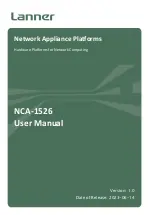
Chapter 6: VLAN Configuration
IEEE 802.1Q Tunneling
– 160 –
IEEE 802.1Q T
UNNELING
IEEE 802.1Q Tunneling (QinQ) is designed for service providers carrying
traffic for multiple customers across their networks. QinQ tunneling is used
to maintain customer-specific VLAN and Layer 2 protocol configurations
even when different customers use the same internal VLAN IDs. This is
accomplished by inserting Service Provider VLAN (SPVLAN) tags into the
customer’s frames when they enter the service provider’s network, and
then stripping the tags when the frames leave the network.
A service provider’s customers may have specific requirements for their
internal VLAN IDs and number of VLANs supported. VLAN ranges required
by different customers in the same service-provider network might easily
overlap, and traffic passing through the infrastructure might be mixed.
Assigning a unique range of VLAN IDs to each customer would restrict
customer configurations, require intensive processing of VLAN mapping
tables, and could easily exceed the maximum VLAN limit of 4096.
QinQ tunneling uses a single Service Provider VLAN (SPVLAN) for
customers who have multiple VLANs. Customer VLAN IDs are preserved
and traffic from different customers is segregated within the service
provider’s network even when they use the same customer-specific VLAN
IDs. QinQ tunneling expands VLAN space by using a VLAN-in-VLAN
hierarchy, preserving the customer’s original tagged packets, and adding
SPVLAN tags to each frame (also called double tagging).
A port configured to support QinQ tunneling must be set to tunnel port
mode. The Service Provider VLAN (SPVLAN) ID for the specific customer
must be assigned to the QinQ tunnel access port on the edge switch where
the customer traffic enters the service provider’s network. Each customer
requires a separate SPVLAN, but this VLAN supports all of the customer's
internal VLANs. The QinQ tunnel uplink port that passes traffic from the
edge switch into the service provider’s metro network must also be added
to this SPVLAN. The uplink port can be added to multiple SPVLANs to carry
inbound traffic for different customers onto the service provider’s network.
When a double-tagged packet enters another trunk port in an intermediate
or core switch in the service provider’s network, the outer tag is stripped
for packet processing. When the packet exits another trunk port on the
same core switch, the same SPVLAN tag is again added to the packet.
When a packet enters the trunk port on the service provider’s egress
switch, the outer tag is again stripped for packet processing. However, the
SPVLAN tag is not added when it is sent out the tunnel access port on the
edge switch into the customer’s network. The packet is sent as a normal
IEEE 802.1Q-tagged frame, preserving the original VLAN numbers used in
the customer’s network.
Содержание SSE-G2252
Страница 42: ...44 General IP Routing on page 627...
Страница 174: ...Chapter 6 VLAN Configuration Configuring VLAN Mirroring 178 Figure 6 27 Showing the VLANs to Mirror...
Страница 511: ...Chapter 14 Basic Administration Protocols UDLD Configuration 518 Figure 14 100 Displaying UDLD Neighbor Information...
Страница 603: ...Chapter 16 IP Configuration Setting the Switch s IP Address IP Version 6 609...
Страница 883: ...Chapter 24 General Security Measures Port based Traffic Segmentation 894...
Страница 989: ...Chapter 30 Congestion Control Commands Automatic Traffic Control Commands 1000 Console...
Страница 1007: ...Chapter 33 Address Table Commands 1019...
Страница 1137: ...Chapter 38 Quality of Service Commands 1150...
Страница 1366: ...Chapter 46 IP Routing Commands Global Routing Configuration 1381 Connected 2 Total 2 FIB 0 Console...
















































